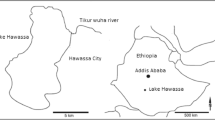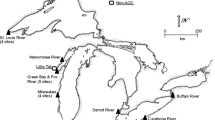Abstract
The osprey (Pandion haliaetus) population nesting along the main stem Willamette River and lower Santiam River was first studied to evaluate contaminants and reproductive rates in 1993 when 78 occupied nests were present. By 2001, the population increased to 234 occupied nests, a 13.7% annual rate of population increase. A sample egg was collected from each of a series of nests along the Upper River (river mile 55–187) in 1993, 2001 and 2006 to evaluate trends of persistent contaminants (organochlorine [OC] pesticides, polychlorinated biphenyls [PCBs], polychlorinated dibenzo-p-dioxins [PCDDs], and polychlorinated dibenzofurans [PCDFs]). Nearly all OC pesticide residues decreased significantly, e.g., p, p′-DDE (DDE) from 2,350 to 1,353 to 210 μg/kg wet weight (ww). PCBs followed a similar pattern over time, e.g., ΣPCBs 688 to 245 to 182 μg/kg ww, while PCDDs and PCDFs showed a more precipitous decline (often 85–95%) between 1993 and 2001, with no egg analyses warranted in 2006. During 2001–2002, sample osprey eggs were also collected from nests at three Headwater Reservoirs and two lower reaches (Newberg Pool and Tidal Portland) of the Willamette River, as well as the lower portion of the Santiam River to evaluate spatial residue patterns. Significant differences were seldom detected among the different sampling areas for OC pesticides (probably due to small sample sizes), although higher concentrations were often seen in the lower reaches, e.g., DDE 901 μg/kg ww (Headwater Reservoirs), 1,353 (Upper River), 1,384 (Newberg Pool) and 2,676 (Tidal Portland). PCB congener concentrations in eggs were usually higher in the Tidal Portland reach than at other locations and often significantly higher than at the Headwater Reservoirs or Upper River. Mercury (first analyzed in eggs in 2001), PCDDs and PCDFs were extremely low in 2001/2002 with no significant spatial patterns. Whole fish composite samples of largescale sucker (Catastomus macrocheilus) and northern pikeminnow (Ptychocheilus oregonensis), which account for about 90% of the biomass in the diet of this osprey population, were also collected from the Willamette River in 1993 and 2001 and analyzed for the same contaminants as osprey eggs. Contaminant residues in fish from the Upper River decreased between 1993 and 2001, paralleling findings for osprey eggs. Likewise, spatial patterns for fish residues paralleled findings for osprey eggs from the different reaches in 2001. A second empirical estimate of biomagnification factors (BMFs) from fish to osprey eggs for OC pesticides, PCBs, PCDDs and PCDFs (ww and lipid weight [lw] basis) was calculated based on residue data collected in 2001. The two independent BMF estimates (1993 and 2001) for each contaminant from the Upper River provide a measure of consistency, e.g., DDE (ww) 87 and 79, (lw) 103 and 112; ΣPCBs (ww) 11 and 8.4, (lw) 13 and 12. Mercury did not biomagnify from fish to osprey eggs (BMF = 0.60). Legacy contaminants investigated had limited (perhaps only DDE), if any, effects on reproductive success of the increasing osprey population nesting along the Willamette River by 2001.




Similar content being viewed by others
References
Ballschmiter K, Zell M (1980) Analysis of polychlorinated biphenyls (PCB) by glass capillary gas chromatography. Composition of technical Aroclor-and Clophen-PCB mixtures. Fresenius Z Anal Chem 302:20–31. doi:10.1007/BF00469758
Bonn BA (1998) Dioxins and furans in bed sediment and fish tissue of the Willamette Basin, Oregon, 1992–95. U.S. Geol. Surv. Water-Resour. Invest. Rept. 97-4082-D, 12 pp
Bonn BA, Hinkle SR, Wentz DA, Uhrich MA (1995) Analysis of nutrient and ancillary water-quality data for surface and groundwater of the Willamette Basin, Oregon, 1980–1990. U.S. Geol. Surv. Water-Resour. Invest. Rept. 95-4036, 88 pp
Braune BM, Norstrom RJ (1989) Dynamics of organochlorine compounds in herring gulls: III. Tissue distribution and bioaccumulation in Lake Ontario gulls. Environ Toxicol Chem 8:957–968. doi:10.1897/1552-8618(1989)8[957:DOOCIH]2.0.CO;2
Burger J, Gochfeld M (1997) Risk, mercury levels, and birds: relating adverse laboratory effects to field biomonitoring. Environ Res 75:160–172. doi:10.1006/enrs.1997.3778
Elliott JE, Machmer MM, Henny CJ, Wilson LK, Norstrom RJ (1998) Contaminants in ospreys from the Pacific Northwest: I. Trends and patterns in polychlorinated dibenzo-p-dioxins and dibenzofurans in eggs and plasma. Arch Environ Contam Toxicol 35:620–631. doi:10.1007/s002449900424
Elliott JE, Machmer MM, Wilson LK, Henny CJ (2000) Contaminants in ospreys from the Pacific Northwest: II. Organochlorine pesticides, polychlorinated biphenyls and mercury, 1991–1997. Arch Environ Contam Toxicol 38:93–106. doi:10.1007/s002449910012
Elliott JE, Wilson LK, Henny CJ, Trudeau SF, Leighton FA, Kennedy SW et al (2001) Assessment of biological effects of chlorinated hydrocarbons in osprey chicks. Environ Toxicol Chem 20:866–879. doi:10.1897/1551-5028(2001)020<0866:AOBEOC>2.0.CO;2
GLIER (1995) Methods and procedures quality manual, 1st edn. O Revision. Great Lakes Institute for Environmental Research, University of Windsor, Windsor, Ontario, Canada, July 1995
Henny CJ, Kaiser JL (1996) Osprey population increase along the Willamette River, Oregon, and the role of utility structures, 1976–1993. In: Bird DM, Varland DE, Negro JJ (eds) Raptors in human landscapes. Academic Press Ltd., London, pp 97–108
Henny CJ, Collins JA, Deibert WJ (1978) Osprey distribution, abundance and status in western North America: II—The Oregon population. Murrelet 59:14–25. doi:10.2307/3534722
Henny CJ, Kaiser JL, Grove RA (2002a) Ospreys in Oregon and the Pacific Northwest. U.S. Geol. Surv. Fact Sheet, FS-153-02 (rev. 2005), 4 pp
Henny CJ, Hill EF, Hoffman DJ, Spalding MG, Grove RA (2002b) Nineteenth century mercury: hazard to wading birds and cormorants of the Carson River, Nevada. Ecotoxicology 11:213–231. doi:10.1023/A:1016327602656
Henny CJ, Kaiser JL, Grove RA, Bentley VR, Elliott JE (2003) Biomagnification factors (fish to osprey eggs from Willamette River, Oregon, U.S.A.) for PCDDs, PCDFs, PCBs and OC pesticides. Environ Monit Assess 84:275–315. doi:10.1023/A:1023396815092
Henny CJ, Grove RA, Kaiser JL, Bentley VR (2004) An evaluation of osprey eggs to determine spatial residue patterns and effects of contaminants along the lower Columbia River, USA. In: Chancellor RD, Meyburg B-U (eds) Raptors worldwide. WWGBP and MME, Budapest, Hungary, pp 369–388
Henny CJ, Kaiser JL, Packard HA, Grove RA, Taft MR (2005) Assessing mercury exposure and effects to American dippers in headwater streams near mining sites. Ecotoxicology 14:709–725. doi:10.1007/s10646-005-0023-7
Henny CJ, Grove RA, Kaiser JL (2008) Osprey distribution, abundance, reproductive success and contaminant burdens along lower Columbia River, 1997/1998 versus 2004. Arch Environ Contam Toxicol 54:525–534. doi:10.1007/s00244-007-9041-1
Johnson BL, Kaiser JL, Henny CJ, Grove RA (2008) Prey of nesting ospreys on Willamette and Columbia Rivers, Oregon and Washington. Northwest Sci 82:229–236
Kammerer JC (1990) Largest rivers in the United States. U.S. Geol. Surv. Open File Report 87-242, 2 pp
Lazar R, Edwards RC, Metcalfe CD, Metcalfe T, Gobas FAPC, Haffner GD (1992) A simple, novel method for the quantitative analysis of coplanar (non-ortho substituted) polychlorinated biphenyls in environmental samples. Chemosphere 25:493–504. doi:10.1016/0045-6535(92)90281-U
Li HW, Schreck CC, Bond CE, Rextad E (1987) Factors influencing changes in fish assemblages of Pacific Northwest streams. In: Matthews WJ, Heins CD (eds) Community and evolutionary ecology of North American stream fishes. Univ Oklahoma Press, Norman, pp 193–202
Lincer JL (1975) DDE-induced eggshell thinning in the American kestrel: a comparison of the field situation with laboratory results. J Appl Ecol 12:781–793. doi:10.2307/2402090
Martell MS, Henny CJ, Nye PE, Solensky MJ (2001) Fall migration routes, timing, and wintering sites of North American ospreys as determined by satellite telemetry. Condor 103:715–724. doi:10.1650/0010-5422(2001)103[0715:FMRTAW]2.0.CO;2
Martin PA, de Solla SR, Ewins P (2003) Chlorinated hydrocarbon contamination in osprey eggs and nestlings from the Canadian Great lakes, 1991–1995. Ecotoxicology 12:209–224. doi:10.1023/A:1022554810870
Peterson SA, VanSickle J, Herlihy AT, Hughes RM (2007) Mercury concentration in fish from streams and rivers throughout the western United States. Environ Sci Technol 41:58–65. doi:10.1021/es061070u
Postupalsky S (1977) A critical review of problems in calculating osprey reproductive success. In: Ogden JC (ed) Trans North American osprey research conference. Trans and Proc Series, vol 2. National Park Service, Washington, D.C., pp 1–11
Rattner BA, McGowan PC, Golden NH, Hatfield JS, Toschik PC, Lukei RF et al (2004) Contaminant exposure and reproductive success of ospreys (Pandion haliaetus) nesting in Chesapeake Bay regions of concern. Arch Environ Contam Toxicol 47:126–140. doi:10.1007/s00244-003-3160-0
SAS Institute (1999) SAS user’s guide: statistics, version 8.0 edition. SAS Institute, Inc, Cary, NC
Schmitt CJ, Ludke JL, Walsh DF (1981) Organochlorine residues in fish—National Pesticide Monitoring Program, 1970–74. Pestic Monit J 14:136–206
Schmitt CJ, Zajicek JL, Ribick MA (1985) National Pesticide Monitoring Program—residues of organochlorine chemicals in freshwater fish, 1980–81. Arch Environ Contam Toxicol 14:225–260. doi:10.1007/BF01055615
Spitzer PR (1980) Dynamics of a discrete coastal breeding population of ospreys (Pandion haliaetus) in the northeastern United States during a period of decline and recovery, 1969–1978. PhD Dissertation, Cornell University, New York
Stickel LF, Wiemeyer SN, Blus LJ (1973) Pesticide residues in eggs of wild birds: adjustment for loss of moisture and lipid. Bull Environ Contam Toxicol 9:193–196. doi:10.1007/BF01684824
Tetra Tech, Inc (1992) Willamette River basin water quality study, Component 9—characterization of the Willamette River Main-Stem Ecoregions. Redmond, Washington. Prepared for Oregon Department of Environmental Quality, Final Report TC8983-09
Toschik PC, Rattner BA, McGowan PC, Christman MC, Carter DB, Hale RC et al (2005) Effects of contaminant exposure on reproductive success of ospreys (Pandion haliaetus) nesting in Delaware River and Bay, USA. Environ Toxicol Chem 24:617–628. doi:10.1897/04-141R.1
Van den Berg M, Birnbaum L, Bosveld AT, Brunstrom B, Cook P, Feeley M et al (1998) Toxic equivalency factors (TEFs) for PCBs, PCDDs, PCDFs for humans and wildlife. Environ Health Perspect 106:775–792. doi:10.2307/3434121
Wentz DA, Bonn BA, Carpenter KD, Hinkle SR, Janet ML, Rinella FA et al (1998) Water quality in the Willamette River basin, Oregon, 1991–95. U.S. Geol. Surv. Circular 1161, 35 pp
Wiemeyer SN, Bunck CM, Krynitsky AJ (1988) Organochlorine pesticides, polychlorinated biphenyls, and mercury in osprey eggs 1970–1979 and their relationships to shell thinning and productivity. Arch Environ Contam Toxicol 17:767–787. doi:10.1007/BF01061982
Acknowledgments
This project was partially funded by the Biomonitoring Environmental Status and Trends Program of the USGS administered by J. Coyle. E. Foster, Oregon Department of Environmental Quality, Portland, OR assisted with electrofishing and reviewed an early draft of the manuscript. C. Custer and M. Fitzpatrick made useful comments on an earlier draft of the manuscript. R. Wildman, Oregon State University, provided information on recent fish distribution in the Willamette River. Field assistants on the project included D. Fouts, T. Furlong, M. Henschen, H. Packard, J. Reiher, M. Taft and M. Guarinello. Logistical support and additional information were provided by personnel from Consumers Power Inc., Philomath; Emerald People’s Utility District, Eugene; Eugene Water and Electric Board, Eugene; Pacific Power and Light Company, Albany and Independence; Portland General Electric Company, Salem; and Salem Electric, Salem. The landowners were most helpful; we appreciate access to their land to survey osprey nests and the historical information provided during interviews in 1993 about the year when ospreys first occurred on their land. Any use of trade, product, or firm names is for descriptive purposes only and does not imply endorsement by the U.S. Government.
Author information
Authors and Affiliations
Corresponding author
Rights and permissions
About this article
Cite this article
Henny, C.J., Kaiser, J.L. & Grove, R.A. PCDDs, PCDFs, PCBs, OC pesticides and mercury in fish and osprey eggs from Willamette River, Oregon (1993, 2001 and 2006) with calculated biomagnification factors. Ecotoxicology 18, 151–173 (2009). https://doi.org/10.1007/s10646-008-0268-z
Received:
Accepted:
Published:
Issue Date:
DOI: https://doi.org/10.1007/s10646-008-0268-z




